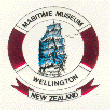Wellington Maritime Museum
 |
? |
The Wellington Maritime Museum closed on 13 September 1999. The Museum of Wellington City & Sea opened on 27 November 1999.
The Museum combines the best of the maritime museum collection with stories of Wellington's social history.
|
Maritime heritage is celebrated on level 1 of the Museum in both the By the Sea We Live and Wahine Galleries. Nearly one half of the new Museum is devoted to Wellington's maritime history, in recognition of the role the harbour and port has played in shaping the city we have today.
History
The Wellington Maritime Museum was set up by the Wellington Harbour Board in the early 1972 on the first floor of the Bond Store.
Donations from the public allowed the Board to extend the Museum and, in 1974, full-time curator Jack Churchhouse was appointed. Under his guidance the Museum gathered a large collection maritime artefacts and archives of local and national significance.
When the Harbour Board was abolished in 1989 as a result of local government reforms, the Museum became a charitable trust. A year later it was renamed the Wellington Maritime Museum.
In late 1995 the Wellington City Council established the Wellington Museums Trust to administer its four museum services, and the Trust took over administration of the Maritime Museum in March 1996.
Under the Trust's guidance, the museum's mission became: 'preserving, presenting and promoting Wellington's heritage, harbour, city and sea'.
To achieve this goal, the Trust embarked on a major redevelopment project to bring the museum into a new era.
Following refurbishment and redevelopment, this historic category one building will now be a storehouse for Wellington's most important product, its history - both social and maritime.

|

